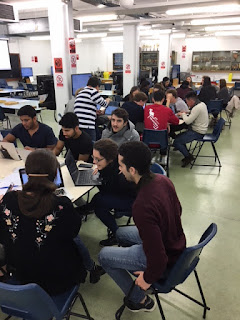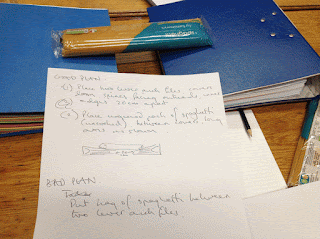...and everybody brought their laptops (Day 1)
Diary /ˈdʌɪəri/ A book in which one keeps a daily record of events and experiences
I used to keep a teaching diary - particularly with new modules and teaching - something to refer to the following year. Seems more appropriate to use blogspace this year.
AM
We started Day 1 with a fairly conventional powerpoint presentation - always a turn off and I think something that could be replaced with an interactive exercise next year. We managed to use the colour of the collaboration tables to organise the students effectively. As an experienced teacher, it immediately presented an unusual classroom in the number of tutors and technicians present. This made it feel unusual, special. Artists introduced themselves - maybe we should all introduce ourselves (students included) next year?
For bridge building, we used the coloured collaboration tables to direct students into groups. The preallocated groups managed to absorb newcomers and cope with absentees so that each group was a mix of engineer (s) and biomedical scientists. Groups built spaghetti bridges were beautiful and varied. We asked for effective and poor documentation and that allowed us to bring the group back together to discuss criteria which will be fed back into learning outcomes. As expected most criteria were "technical" rather than "critical" emphasising the importance of introducing critical reflection questions into later sessions. Gathering these together on screen seemed to work well.
We broke with the plan when Shelley suggested that they show their work to the group in turn and Celia led the discussion at each table. It both models the Pecha Kucha and mirrors their final assessment - an excellent idea. The story-telling about each bridge became successively more developed with each group. A lot of humour, smiles. The slight overrun did not bother anyone.
PM
Kawal's session seemed excellent. Everyone bought their laptops. All the students seemed really engaged in the software and printing process. Again the students stayed beyond the end of their session - highly unusual.
some observations
- For the bridge task, we asked that the bridge span >1 spaghetti length: as Les pointed out its worth considering how this changes the nature of the task compared to a gap < 1.
- In asking the group for their thoughts on learning outcomes, we should ask them as a group to select five terms (or 20%) that they might chuck out to refine the set - not because it needs refining but it asks them to focus again on their work and examine its usefulness.
- Team teaching encourages reflexive in response to the classroom - allows students to lead the way. Reflexivity is a big plus for all.
- Team teaching encourages conversation. I used the opportunity to discuss my upcoming session with Les and Shelley (history and significance of anatomical models). Should this be the insignificance of models. Without reference to biological reality, how does a model become meaningful. What referencing makes it come alive?
- It was great to be able to encourage the students to use their phones, take pictures, document and share.
- The distinction between year group and discipline was invisible to me. Everyone seemed to have a voice.




Comments
Post a Comment